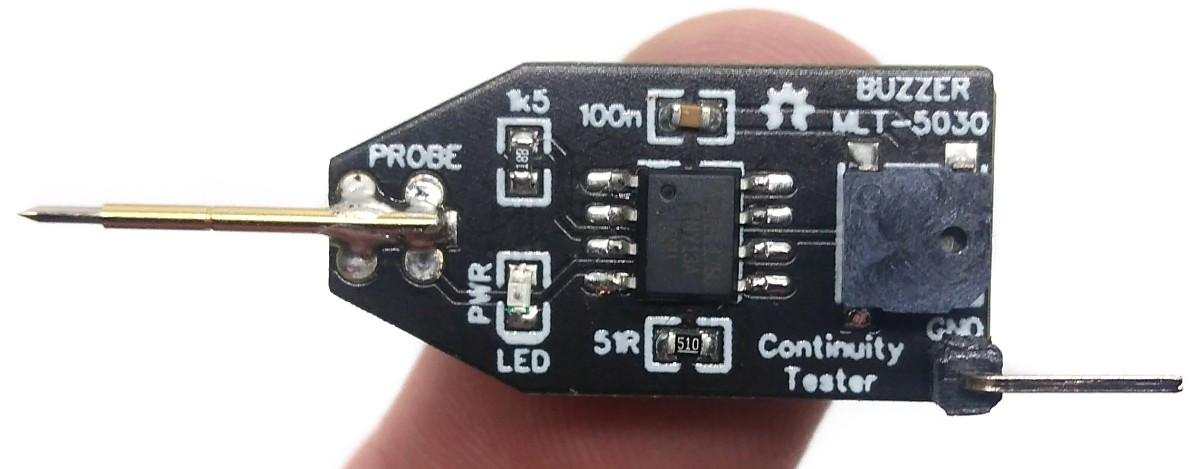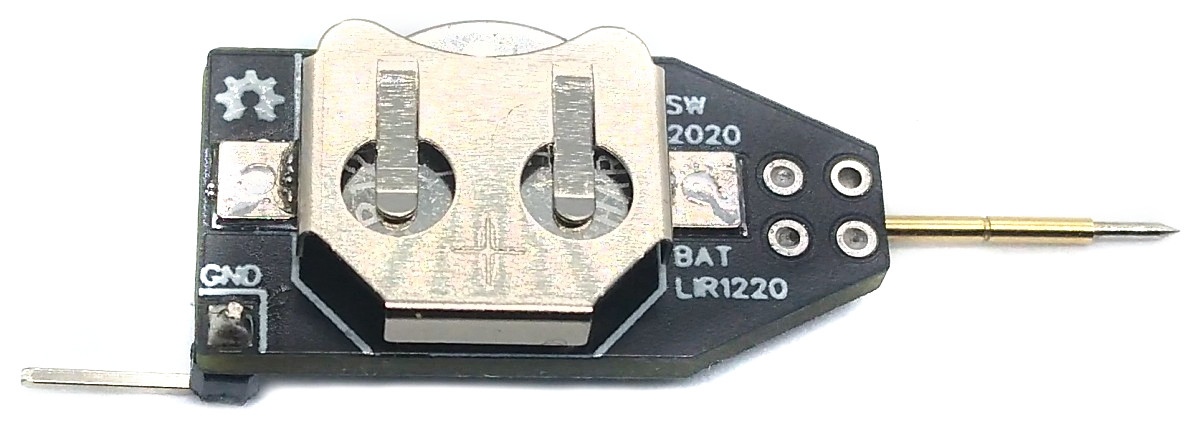Continuity Tester based on ATtiny13A
The simple yet effective Continuity Tester is just a conversion of the original one by David Johnson-Davies from the ATtiny85 to the ATtiny13A. It is designed to check circuit wiring and PCB tracks.
- Project Files (EasyEDA): https://easyeda.com/wagiminator/attiny13-continuity-tester
Hardware
The basic wiring is shown below:
Connect one end of a wire to the GND terminal and use the other end together with the pogo pin to check the continuity of wires and traces. The device is powered by a 1220 coin cell battery. Please remember that only the rechargeable LIR1220 Li-Ion batteries work. The "normal" CR1220s don't deliver enough power for the buzzer.
Software
Implementation
The code is using the internal analog comparator of the ATtiny. By using the internal pullup resistors on both inputs of the comparator and by using a 51 Ohm pulldown resistor to form a voltage divider on the positive input, the comparator output becomes high if the resistance between both probes is less then 51 Ohms. This indicates a continuity between the probes and the buzzer will be turned on. For a more precise explanation refer to David's project. Timer0 is set to CTC mode with a TOP value of 127 and no prescaler. At a clockspeed of 128 kHz it fires every millisecond the compare match A interrupt which is used as a simple millis counter. In addition the compare match interrupt B can be activated to toggle the buzzer pin at a frequency of 1000 Hz, which creates a "beep". If no continuity between the probes is detected for 30 seconds, the ATtiny is put into sleep, consuming almost no power. The device can be reactivated by holding the two probes together. The LED lights up when the device is activated and goes out when the ATtiny is asleep. The code needs only 252 bytes of flash if compiled with LTO.
// libraries
#include <avr/io.h>
#include <avr/sleep.h>
#include <avr/interrupt.h>
// pin definitions
#define REF PB0
#define PROBE PB1
#define LED PB2
#define EMPTY PB3
#define BUZZER PB4
// global variables
volatile uint16_t millis = 0; // counts milliseconds
const uint16_t timeout = 30000; // 30 seconds sleep timer
// main function
int main(void) {
// setup
set_sleep_mode (SLEEP_MODE_PWR_DOWN); // set sleep mode to power down
PRR = (1<<PRADC); // shut down ADC to save power
DDRB = (1<<LED) | (1<<BUZZER) | (1<<EMPTY); // LED, BUZZER and EMPTY pin as output
PORTB = (1<<LED) | (1<<REF) | (1<<PROBE); // LED on, internal pullups for REF and PROBE
OCR0A = 127; // TOP value for timer0
OCR0B = 63; // for generating 1000Hz buzzer tone
TCCR0A = (1<<WGM01); // set timer0 CTC mode
TCCR0B = (1<<CS00); // start timer with no prescaler
TIMSK0 = (1<<OCIE0A); // enable output compare match A interrupt
PCMSK = (1<<PROBE); // enable interrupt on PROBE pin
GIMSK = (1<<PCIE); // enable pin change interrupts
sei(); // enable global interrupts
// loop
while(1) {
if (ACSR & (1<<ACO)) TIMSK0 |= (1<<OCIE0B);// buzzer on if comparator output is 1
else TIMSK0 &= ~(1<<OCIE0B);// buzzer off if comparator output is 0
if (millis > timeout) { // go to sleep?
PORTB &= ~(1<<LED); // LED off
PORTB &= ~(1<<REF); // turn off pullup to save power
sleep_mode(); // go to sleep, wake up by pin change
PORTB |= (1<<REF); // turn on pullup on REF pin
PORTB |= (1<<LED); // LED on
}
}
}
// pin change interrupt service routine - resets millis
ISR (PCINT0_vect) {
millis = 0;
}
// timer/counter compare match A interrupt service routine (every millisecond)
ISR(TIM0_COMPA_vect) {
PORTB &= ~(1<<BUZZER); // BUZZER pin LOW
millis++; // increase millis counter
}
// timer/counter compare match B interrupt service routine (enabled if buzzer has to beep)
ISR(TIM0_COMPB_vect) {
PORTB |= (1<<BUZZER); // BUZZER pin HIGH
}Compiling and Uploading
Since there is no ICSP header on the board, you have to program the ATtiny either before soldering using an SOP adapter, or after soldering using an EEPROM clip. The AVR Programmer Adapter can help with this.
If using the Arduino IDE
- Make sure you have installed MicroCore.
- Go to Tools -> Board -> MicroCore and select ATtiny13.
- Go to Tools and choose the following board options:
- Clock: 128 kHz internal osc.
- BOD: BOD disabled
- Timing: Micros disabled
- Connect your programmer to your PC and to the ATtiny.
- Go to Tools -> Programmer and select your ISP programmer (e.g. USBasp).
- Go to Tools -> Burn Bootloader to burn the fuses.
- Open ContinuityTester.ino and click Upload.
If using the precompiled hex-file
- Make sure you have installed avrdude.
- Connect your programmer to your PC and to the ATtiny.
- Open a terminal.
- Navigate to the folder with the hex-file.
- Execute the following command (if necessary replace "usbasp" with the programmer you use):
avrdude -c usbasp -p t13 -U lfuse:w:0x3b:m -U hfuse:w:0xff:m -U flash:w:ContinuityTester.hex
If using the makefile (Linux/Mac)
- Make sure you have installed avr-gcc toolchain and avrdude.
- Connect your programmer to your PC and to the ATtiny.
- Open the makefile and change the programmer if you are not using usbasp.
- Open a terminal.
- Navigate to the folder with the makefile and main.c.
- Run "make install" to compile, burn the fuses and upload the firmware.




